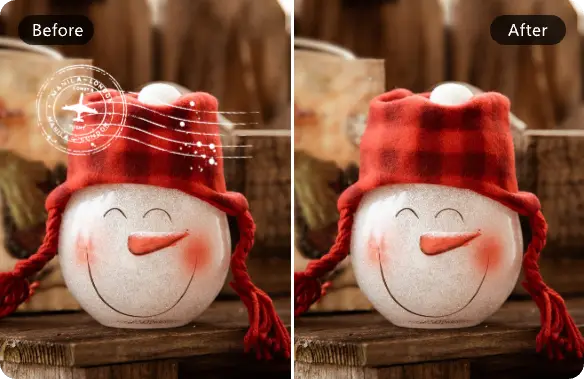Watermarks have a critical function in identifying ownership of material items like images, videos and any other material. Despite the fact that these watermarking systems are very useful in preventing any unauthorized use or distribution of digital contents, there are situations whereby such watermarks are required to be erased legally or materially. Such has prompted the creation of new AI-based watermark removal tools that have greatly improved image cleaning up for the various sectors including companies, bloggers, and graphic designers. This article will present the main AI applications’ categories, and how they transform the image manipulation applications.

E-Commerce Product Listings
High-quality images are important for e-commerce websites since people have to be attracted and this shows professionalism to the customer and in turn sells the products. As more and more products and services are being sold online today’s customer is attracted to a beautiful picture which in fact describes the material they wish to buy. However, businesses directly purchase visuals from stock image providers and most of them contain watermarks. Although such watermarks help protect image creators, they have a negative appearance when not properly erased from a retailer. This is especially so for small business or start-ups especially when they can hardly afford to hire a professional photographer or graphic designer to develop unique images.
Smart applications in e-commerce have thought to be a revolution driving a watermark removal tool. Such tools can easily delete those watermarks from such licensed images as well as guarantee high image quality and no need for extra edition (Smith, 2023). For instance, a small retailer sourcing stock photos to use in displaying their products may easily wash watermarked visuals using AI solutions. It also helps the company to ensure that the images used on their online store are professional and standard, which will go a long way in convincing the customers to trust the company hence enhancing the overall experience of shoppping.
It is also important to note that AI can work through the removal of watermark in large quantities thus saving effort for businesses. Not only does this automation help reduce the time spent on preparing product listings but also makes e-commerce teams free to work on other problems, for instance, marketing. Lastly, through the AI watermark removal technology, business organizations are in a position to represent their products or services in a better way to increase the brand image and customer satisfaction in equal measures.

Social Media Content Creation
Both influencers and marketers know that the first step towards establishing an audience and keeping them engaged is through the use of appealing graphics. On Instagram, TikTok, or Pinterest where the imagery rules, the quality of images determines successes or failures of a given campaign. Although serving the purpose of preserving authorship during the crafting of graphics and images, watermarked images look unpolished when published online. They may disorient the audience, mar the generalized appearance and may wreck the reputation of an influencer’s account.
Such AI tools as watermark removers are really valuable in this regard because influencers can receive the clean and polished visuals within minutes. These tools will help to automate the removal process keeping intact the beauty of the images so that influencers will be able to concentrate on creating quality content instead of bogged down by hundreds of selfies. In particular, time is of concern for influencers, who always face huge pressure to build their content, work with brands, and communicate with their followers (Johnson & Lee, 2022). For instance, an influencer working with a professional photographer may receive watermarked drafts for example. When the final images are selected, and the rights to particular images are obtained, AI solutions can automatically remove watermarks. This cultivates the final content in über-related form and guarantees that there can be seamless sharing of content across different platforms without tensions. Moreover, these tools enable influencers to keep the visuals they use more professional and matching the concept of their account. Thus, the desire to include AI watermark removers to their working process can help influencers and marketers increase the value of content, at the same time maintaining productivity rates with the speed and dynamism of online platforms.

Stock Photos for Commercial Use
Typically, the watermarks serve as a way to protect preview images from piracy and guarantee that the owners of the accounts follow the rules of intellectual property protection. While these watermarks are useful during the picture selection and licensing, they become a problem once a business or designer has acquired the rights for their image. In such cases, the AI solution is the most effective approach to eradicating such marks continually. In its simplest sense, these tools take what used to be time-consuming exercises and enable users to efficiently prepare images for use in creative projects (Kumar, 2021). AI watermark removal not only saves or regain time lost but also the quality of the image is preserved and does not undergoing distortions or inconsistency as it may when manually removed. This precision is especially crucial in business and professional environment because any deviation from aesthetic appeals to compromises the professionalism of produced material.
Updating Legacy Content
Photographers as well as designers will always go back to a previous photo collection in an attempt to update it with new content, change with content for current trends or transform visual in an attempt to serve some other purpose. Often such projects contain watermarked images scanned from previous licensing contracts or images with incorrect practices, which are no longer used. It is thus quite laborious and error and difficult for specialists along with other practitioners to manually edit these images to erase the watermarks. This is why there are AI watermark removers available on the market, designed with the purpose to let users restore such content without damaging its quality (Taylor, 2023).
These elaborate instruments employed efficient process of recognition and expulsion of watermarks without breaking the basic framework of the image, which in total takes lesser time than manual erasing of the watermarks. For example, a wedding photographer who logs into their archive and looks for proofs or promotional prints may initially see the images watermarked. By applying the several AI tools, they can delete such marks in a single click to maintain their portfolio’s standard in terms of professionalism to reflect the recent projects.
Further, the designers who are handling old content can use the AI tool to utilise the visuals for new campaigns or projects as they do not need to create them absolutely anew. This capability allows the professional to optimise the completion and reuse value from his or her work, with a view of responding to shifts in the marketplace within the shortest time possible in order to satisfy the client needs. Finally, AI watermark removers help photographers and designers to enrich their portfolios and offer them new opportunities to use their archives, increasing productivity in creative processes.

Collaborative Projects
Designers often work with other designers, marketers, and other people involved in creating marketing materials, advertisements or content for social media or websites. In the early stages of a project to avoid cases where designs and images are copied, they are usually sent with a watermark to discourage anyone from using them. Theses watermarked drafts are mostly meant for feedback purposes, approval, or review. The second difficulty is the watermark, which has to be deleted after all participants agreed with the content of the project and wanted to have a perfect result. AI-powered tools make it possible to take out watermarks from images, free, fast and efficiently. The use of computer generated formats also removes the frequency of manual editing, another time consuming and tiresome exercise which is likely to take a lot longer. This is because AI increases the productivity of work by automatically removing the watermark, which the creative team should spend their time on more valuable parts of the project such as fine-tuning designs, intensive marketing planning, or innovation (Chen et al., 2021).
Educational Materials
Educators and trainers find in visual resources valuable tools to support their practices, as visual materials are particularly relevant to facilitate learning processes and to explain concepts. Speaking about the use of licensed stock images or third-party content, which can be also effective in the process of education, it is possible to mentioned that often such images contain watermarks that look rather intrusive and unprofessional in the given context. As for the harms, with the help of AI tools for watermark removal, instructors are able to erase these marks without any issues, providing viewers with nicely refined materials concerning the subjects, where learners do not have to pay attention to watermarks interfering with the material’s focus (Williams & Patel, 2022).
For instance, a graphic design instructor who is teaching his or her students how to make a flyer will insert some stock images in the process of developing the flyer for some teaching purposes. In such scenarios, watermarks can be a problem since they serve to distract the learner from the learning material. By using the AI tools, one can easily overwrite the watermark while still maintaining the image quality that therefore, the student’s attention will be mostly on the tutorial rather than blurring by irrelevant watermark. This capability also improves the outlook of the entire process in order to produce a professional and effective presentation of the learning sessions.

Benefits of AI Watermark Removal
The application of AI technology in watermark removal offers great advantages, hence the significance of the subject matter especially under four domains; efficiency, precision, accessibility, and cost. The usage of these tools will also greatly minimize the time spent on the post-editing of the highlights. As stated by Garcia (2023), which used to required an extended amount of time applying the regular techniques or steps, can now be done in just a few minutes. Such efficiency enhances the concentration of the workers’ skills on more creative and tactical assignments, thus boosting efficiency.
Accuracy is still another advantage that AI possesses in removing the watermarks. Using sophisticated algorithms, developers ensure that when watermarks are erased, the picture is restored with little or no interference (Zhang et al., 2021). Such precision guarantees that fine and detailed services match the expectations of modern businesses such as e-commerce, graphic design, and photography.
Due to the openness of AI applications, it becomes evident that the tools are very useful for everyone not just anybody with expertise in the system. According to Miller and O’Connell (2022), this is due to interface simplicity and design friendly to any common person making them be able to produce professional outputs. This democratisation of image editing means that even companies, writers and individual freelancers can accomplish what used to need professional skills.
The last benefit of AI tools is concern to do with cost saving since the use of such tools minimizes on the use of professional editors for repetitive tasks. Hernandez, (2023) Observes that it becomes possible to reduce the bills of outsourcing whilst gaining(\”hole\”) the optimal results of the edited works, especially where they are mundane in nature. Such conditions, combined with the high speed of operations, accurate determination of parameters, openness for the user, and cost-efficiency of the tools, have made AI watermark removal undispensabe for today’s professional media creators.
Ethical Considerations
Even though such applications as AI watermark removers represent rather effective tools that provide user convenience, their application should not transcend the ethical and legal norms. Using techniques that delete watermarks without the creator’s approval is unjustified because work is under the protection of intellectual property rights. They can result in severe legal penalties, litigation or fines, and business loss (Anderson, 2021). These tools are meant to be helpful whenever true watermark eradicating is appropriate, for example editing purchased stock photographs, utilizing old content for digital work or working with a legitimate permission. But it erodes the rights of the creators, and it is against the ethical practice that the creative world holds dear. It is recommended therefore always to check on licensing agreements and to seek sort permission when removing watermarks from an image. Ethical measures not only prevent legal consequences but also recognize talent and encourage cooperation between the workers of this field.
Conclusion
AI watermark removers are necessarily helpful applications for photographers, designers, social media influencers, and businesses. Being used in improving the visuals of e-commerce products to maintaining efficient collaborative processes, these technologies make people work smarter. However, their use should be done under practices that gave consideration to the rights of the individual’s original to that work. By using AI instruments properly, individuals can open a new level of productivity, and stay relevant in the world that goes digital.

